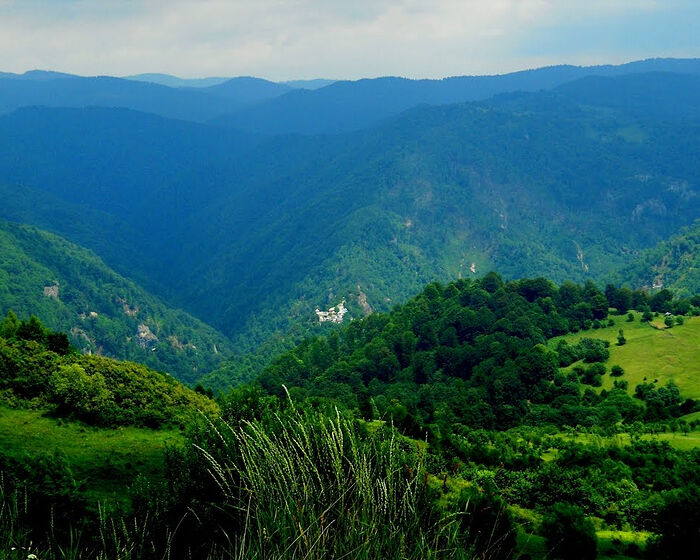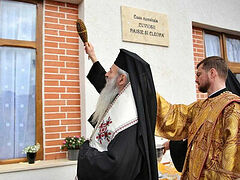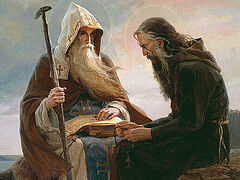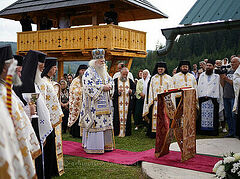 The surroundings of Cetățuia Negru Vodă Monastery
The surroundings of Cetățuia Negru Vodă Monastery
Throughout his time in Cetățuia, out of all the many cells scattered across the narrow Valley of Cells, Fr. Modest has been able to visit the cells of only seven schema-monks, because he almost always stumbles upon a mother bear with her cubs, not to mention that it’s very hard to climb there. For example, Schemamonk Pamvo occupies a cave somewhere between the Valley of Cells and Comana Valley, and it takes him three to four hours to get to the monastery using a shortcut known only to him. No one has the slightest idea how he does it, but he always arrives at the monastery from someplace above the cells.
“He doesn’t go around the mountain to climb along the path, like everyone else does. He shows up from behind, from the side of Comana Valley that has no walking paths at all, as if he traverses the skies,” the abbot marvels.
He often finds him next to the memorial cross or another place, such as the cave of Zamolxis, also located above a deep precipice. Pamvo is the recluse who comes to the monastery most often—every month or two. He needs to go to church and attend the Liturgy. He confessed to Fr. Modest once. But he also spends winter in an unheated cave and never asks for anything.
“I can’t say we talk much when we see each other—maybe a word or two. He once told me that when you pray, you feel such a burning in your heart that it warms you in the cold, and you no longer feel it at all.
He looks young and strong, but I’ve heard he’s well over eighty. He’s also known for repeatedly saying: “Life is the most precious gift given to man!” That’s all he says: “Don’t forget you have to treasure life!”
Fr. Modest also knows two other hesychasts residing in the far end of the Valley of Cells, towards the Bucegi Mountains: Schemamonks Nikolai and Tikhon. They also came a long time ago, back in 1998, having travelled through all of the Eastern Carpathian Mountains to the south in search of this famous valley.
He’s got a saying: “Life is the most precious gift given to man!” That’s all he says: “Don’t forget you have to treasure life!”
“There’s something about both of them… Russians; they speak Romanian with difficulty. It struck me that their appearance hasn’t changed since they arrived. Nikolai is undoubtedly rather old, possibly more than 100 years old, who knows… They’re ageless. But Tikhon, his disciple, is young—maybe a little over seventy. I think they live in the same cave together, so Tikhon can take care of his elder. I’ve known about this cave for twenty-three years, but I’ve never gone there. We meet only at specially designated places. They once told me that they came here because they heard that the Valley of Cells was the place of ascetic labors of a great many ancient saints, and that they will remain here until they die.
I must note that it wasn’t so easy to get this information about the hesychasts from Fr. Modest. At first, he didn’t want to say anything. He’d pause in the middle of a sentence, hesitating to continue. He didn’t reveal any names until the very end. He maintained that even if a bishop ordered him to disclose their whereabouts, he’d still keep it secret.
He has known the hermits for a long time and he also knows that they are men of God. He’s convinced that some of the caves he’s found undoubtedly hold someone’s bones or incorrupt relics.
“There’s a cave there, on the other slope, with two stone mushrooms by the entrance, with one on each side, thresembling the Babele rocks in the Bucegi Mountains. A small recess for an icon can be seen above the cave entrance. The ceiling is half-collapsed, but inside you can still see the semblance of a bed carved out of stone, and ancient inscriptions identical to the ones in the cave of St. Ioanichie dating back to 1638.1
Somewhere below, right underneath our cells, there’s another cave, very ancient, big enough for five people. It’s partially preserved, but its entrance is blocked by a wall of boulders. I’m sure the body of some ascetic rests there, but I don’t want to disturb him. I don’t want to show anyone this place either. I don’t consider myself worthy of digging it up; the responsibility is too great. I decided that it will happen whenever it pleases God.
Fr. Modest knows perfectly well what reclusion is. He already has the experience of having lived with a saint. He rejected world at the age of eighteen. In 1982, he was already living in the monastery in Sitaru.2 It didn’t matter to him that he graduated from two universities and received two Masters degrees in the theology and history, or that he became the right-hand man to His Beatitude Theophan, vicar to the Patriarch.3 He served in Bucharest and a bright future awaited him, but in 1992 he renounced it all following a miraculous event he rarely speaks about. I’ll tell it here word for word.
The saint of the oak grove
“I was living at Antim Monastery4 then, but I always sought solitude. In the summer of 1992, I asked for a blessing to spend some time in solitude somewhere in the mountains to gain my strength. Since childhood, I’ve cherished the memory of how we, as kids, were walking somewhere in the Bucegi Mountains when we were suddenly caught in a downpour and had to huddle inside some kind of a grotto that had an icon hanging above the entrance. We sat there huddled together, and I realized I’d never been so happy in my whole short life.
And now I wanted to find this cave, the priceless treasure of my childhood. But I couldn’t find it. I got lost somewhere at the top of the mountain and spent hours wandering through the juniper thicket. There was no light coming from anywhere, and I had no idea where to go. I practically climbed on all fours underneath the bushes. Suddenly, there came the sound of the faint murmur of the water. I followed it, but didn’t see any water. All I knew was it was somewhere below. Then some voice told me: “Walk ahead.”
Suddenly I found myself in a small oak grove bathed in an orange glow, and I vividly remember an abandoned chapel on the right of me, lurking under a rock and blanketed with long grasses, wet and thick as liana. It was tiny, like a hut. To the left was a mud hut inside a stone hollow, all camouflaged with grass. Had I approached from any other side, I would never have noticed it.
The sound of water I followed turned out to be a spring coming right out of the rock. Then I saw a hermit in the grass, and he said to me: “You’re lost, son. You’re lost…” He hadn’t seen a human for sixty years. He came to this glade at the age of twenty-four, and now he’s eighty-four. No one at all had found that glade until that day. “It’s impossible to get here unless it’s God’s will,” he told me.
I spent three days with this hesychast in his mud hut. Three days! And I felt like I learned much more about God than was possible in any theological courses. I was the first person he’d spoken to in sixty years! He was surrounded by an aura of holiness, it seemed to me. I don’t know why, but I never wanted to leave him. To this day, I regret that I didn’t stay. I asked him about it, but he simply replied: “This place isn’t for you. There are many people who need you there.”
 Protosinghel Modest (Ghinea). Photo by: Mihai Raitaru
Protosinghel Modest (Ghinea). Photo by: Mihai Raitaru
I kept looking back as I walked away from the oak grove, and he just smiled, watching after me. I never saw him again, but our meeting turned my life around. I started persistently asking the Patriarchate for a transfer somewhere deep in the mountains, to a remote monastery: “Anywhere! Anywhere where it will be more difficult and more secluded,” I asked.
At last, in 1993, I was sent here. I knew nothing about Cetățuia or the hermits, and the skete was in desolation. Then I unearthed St. Ioanichie, which was a great joy for me. Later on, I learned about the hesychasts, and then followed the rest of the story I’ve already told you about.
 A new church at Cetățuia Negru Vodă Monastery. Photo: Ruxandra Chiurtu
A new church at Cetățuia Negru Vodă Monastery. Photo: Ruxandra Chiurtu
The death of Pahomie
In 2017, when Schemamonk Pahomie died, his wolf howled in grief. The hermit Pamvo heard it and came to the monk’s cave. Then he ran to me: “Let’s go, Father Abbot, because Brother Pahomie has departed to the Lord…” I was standing on the cliff behind the monastery when he appeared—“across the sky”—the way he always came. I hurriedly grabbed a few candles and went with him.
Meanwhile, the hermit Tikhon arrived at Pahomie’s cave to keep vigil over him under the light of an oil lamp. I peeked inside: It turned out he had dug his grave in advance, right there, inside his cave. He had also lugged stone slabs from the mountain to be placed on top of it.
Fr. Tikhon only told me that Pahomie knew the hour of his death in advance and had revealed it to him. He also left his last will that no cross or sign, or anything at all be placed inside his cave, and that no one be told where he died, because he desired to leave this world as a “nobody.”
Kind Pamvo, Tikhon, and Nikolai and I buried him there three days later. Everyone offered up a prayer… and that was it.
I’ll never forget this hermit’s face as he lay stretched on the blanket. It was radiating light
But I’ll never forget this hermit’s face, when I looked at him stretched in front of me on the blanket before we lowered him in his grave. It was radiating light! I give you my word.
His face was lit with a smile and emanated kindness that no one could have ever suspected in this grim-faced and quick-tempered man. I confess that I was in tears. He was truly the living dead, fully reconciled to God.
I also saw before that how water from a mountain spring was running across his cave on the right along a narrow ditch, past the cave entrance down to a cavity hewn in the rock. It was one of very few springs available in these desolate and barren mountains. That’s why Pahomie never needed drinking water. But then, on the day of his death, the spring suddenly dried up.
 The Valley of Cells in the fall
The Valley of Cells in the fall
I come here from time to time, light a candle, and watch for the water to reappear, but not a single drop has come out since he reposed. It has dried up for good.




